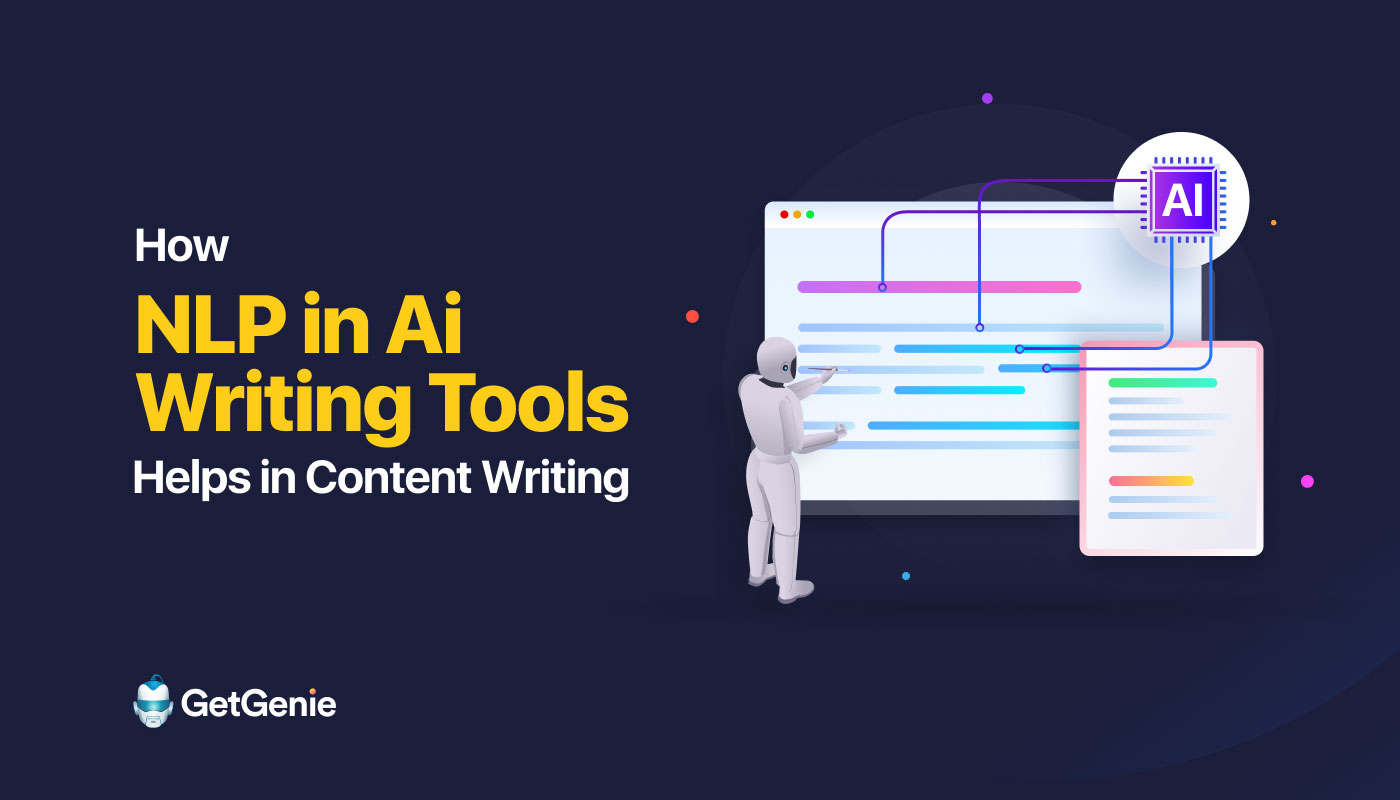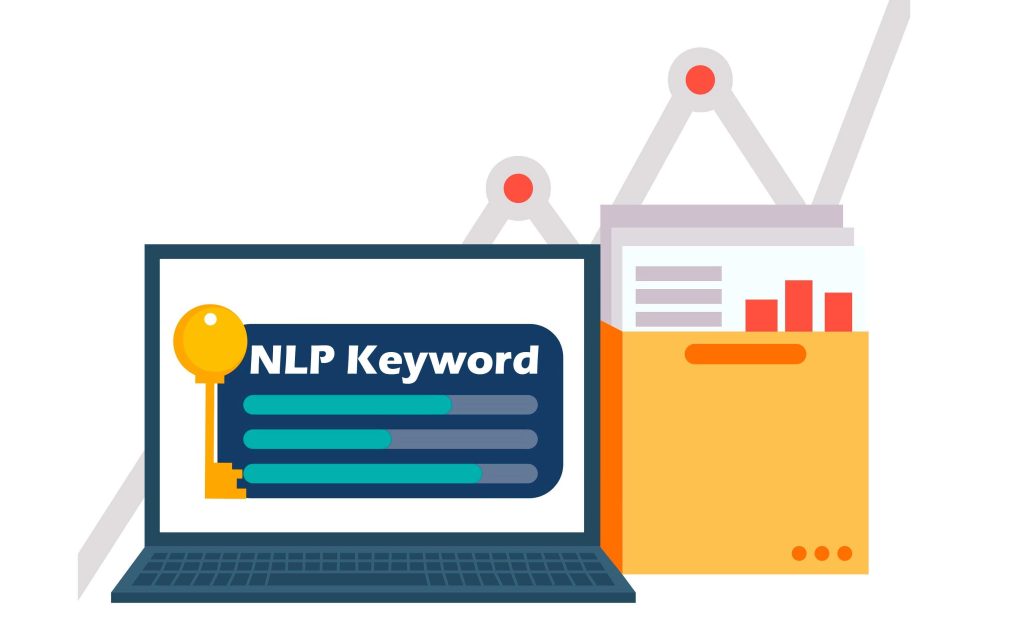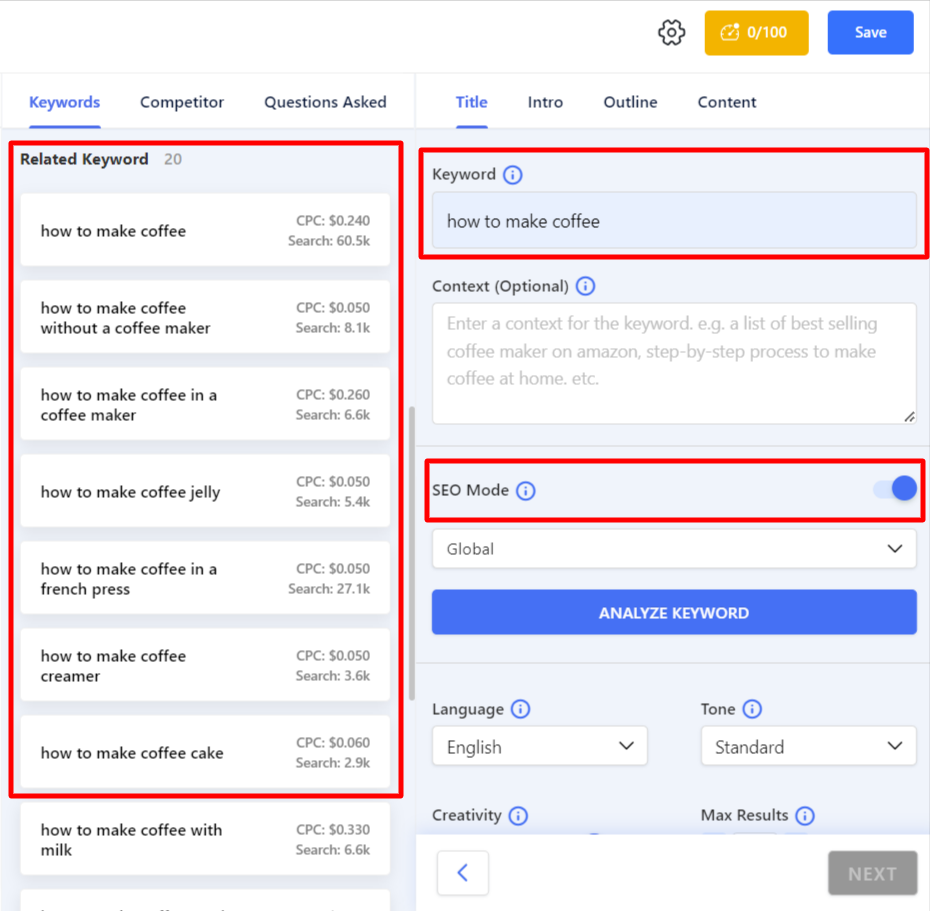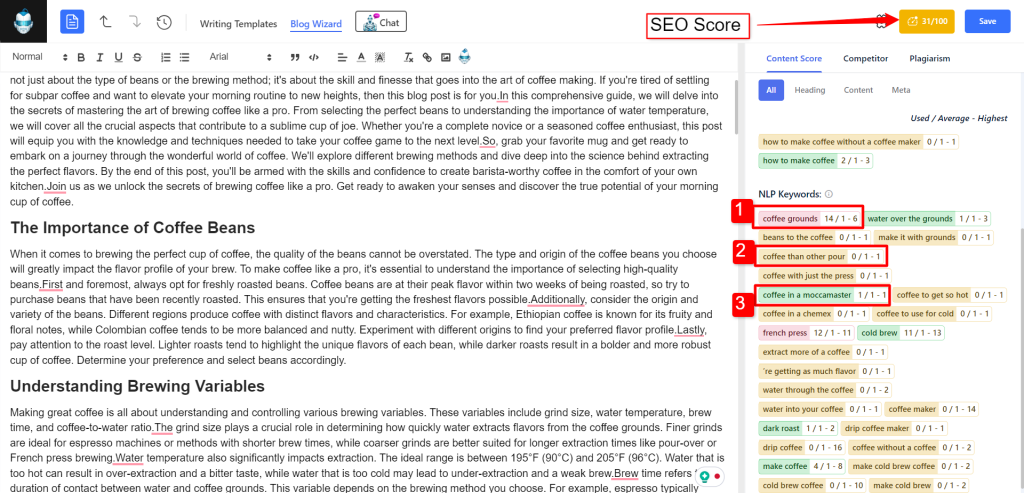How NLP in AI Writing Tools Helps in Content Writing

The integration of NLP (Natural Language Processing) in AI writing tools made a paradigm shift in the way we approach content writing. This powerful combination has created a new era where AI writing tools no longer just generate generic text. Instead, now they create contextually meaningful content that matches the level of humans, to some extent.
When applied to content writing, NLP-driven AI tools bring a massive transformation to the process. These tools possess the capacity to analyze vast amounts of text data and also learn grammar rules, linguistic nuances, and even specific contexts.
In this article, we will focus on the details of NLP; its definition, its impact on keyword analysis, and how AI writing tools utilize the power of NLP to generate content with more efficiency.
What is Natural Language Processing (NLP)?
Imagine chatting with a computer that gets your jokes and understands your demands. NLP has made it possible.
Natural Language Processing (NLP) is a field of Artificial Intelligence (AI) and computational linguistics that focuses on facilitating computers to understand, interpret, and generate human-like text in a meaningful and useful way. Popularly, NLP is considered a bridge between human communication and computer understanding.
In short, this technology allows machines to interact and process text or speech data in a manner similar to how humans perform.
NLP involves a wide range of tasks and applications, including:
- Language understanding
- Human-like text generation
- Text-to-speech conversion
- Machine translation
- Developments of chatbots and virtual assistants
How NLP in AI writing tools helps to generate better content
NLP in AI writing tools can help to generate high-quality content with contextual understanding, grammar correction, analysis of emotional tone, content personalization, and so on.
Moreover, NLP (Natural Language Processing) plays a crucial role in AI writing tools by enabling them to generate better content through various mechanisms and techniques.
👉 Analysis of emotional tone
Analyzing emotional tone through NLP is a process that utilizes computational methods to interpret emotions expressed in written or spoken language. This multifaceted approach involves several key components:
- Sentiment Analysis: NLP operates sentiment analysis to measure the overall emotional sentiment of a text. This can range from identifying whether the sentiment is positive, negative, or neutral. This technique is valuable for understanding the general emotional context of a given text.
- Emotion Classification: NLP models can be trained to categorize text into specific emotional categories. By learning from annotated data, these models can accurately label text with emotions like happiness, anger, sadness, fear, surprise, disgust, or anticipation. This approach provides a granular understanding of the emotional composition of a given piece of content.
👉 Contextual understanding
Recognizing emotions requires considering the context in which language is used. Advanced NLP models are designed to detect sarcasm, irony, and shifts in sentiment within a conversation or narrative. This contextual awareness enhances the accuracy of emotional tone analysis.
Overall, deep learning models such as Text-DaVinci-003 and Generative Pre-trained Transformers (GPT) are proficient in capturing emotional nuances in text. These models can be fine-tuned on labeled emotion datasets to refine their emotional analysis capabilities. Moreover, NLP techniques are extendable to various languages, facilitating cross-cultural emotional understanding.
👉 Grammar correction
Traditional grammar checkers are used to generate out-of-context and irrelevant at times. Thanks to natural language processing technology, grammar correction is now more relevant than before. NLP utilizes computational techniques to analyze and correct grammatical errors in written text.
Here’s how NLP helps in grammar correction:
- Contextual grammar correction: Advanced NLP models consider surrounding context to suggest corrections that fit the intended meaning.
- Error detection: NLP models recognize common grammatical errors like subject-verb agreement, verb tense inconsistency, and more.
- Suggestion generation: Beyond error detection, NLP-powered tools offer suggestions for correcting errors while maintaining context.
- Suggestion for non-native speakers: NLP tools can be especially useful for non-native speakers, helping them to write more fluently and accurately.
It’s important to note that while NLP has made significant advancements in grammar correction, manual proofreading is still valuable for producing high-quality, error-free text.
👉 Content personalization
Personalized content is always effective for connecting to the audience better. Personalization in content creation through NLP is a technique that facilitates advanced linguistic analysis to create customized user experiences. By analyzing user behavior, interests, and interactions, NLP helps the segmentation of audiences and the delivery of customized content to a specific segment.
Content personalization with Natural Language Processing involves several steps including user data collection, user profiling, segmentation of audience, and generating dynamic content based on user segment.
However, while leveraging NLP for content personalization can deliver impressive results, ethical considerations, and data privacy must remain paramount. Striking the right balance between personalization and safeguarding user information is crucial to maintaining user trust and ensuring the responsible use of technology.
👉 Content in multiple languages
Natural Language Processing can help to generate multilingual content in the following manner:
- Machine Translation
- Multilingual Models
Moreover, NLP generates content in multiple languages using methods like machine translation, multilingual models, code-switching, transfer learning, language generation pipelines, cross-lingual embeddings, data augmentation, and rule-based systems. Human editing ensures accuracy and naturalness.
👉 Impact of NLP on overall content quality
In short, natural Language Processing (NLP) can play a significant role in improving overall content quality by automating and enhancing the process of content creation, editing, and analysis.
NLP-powered tools can automatically generate high-quality content, such as articles, blog posts, product descriptions, and more. NLP content analysis can help to determine which content performs better in terms of user engagement, click-through rates, or other relevant metrics.
Furthermore, NLP can assess the readability of content and provide suggestions to make it more comprehensible to a wider audience. It can recommend sentence restructuring, the use of simpler words, and adjustments to sentence length.
What is NLP keyword extraction and how it works?
NLP keyword extraction is a process of identifying and extracting the most relevant words or phrases from a text.
It can help to summarize the main topics or themes of a document or to find the keywords that best describe the content. These keywords represent the main theme of a topic, or concepts present in the content and can provide valuable insights into its content.

NLP plays a significant role in keyword analysis by enabling computers to understand and extract meaning from human language. Keyword analysis involves identifying relevant keywords and phrases that people use to search for information online. NLP techniques can help in various aspects of keyword analysis:
✅ Keyword extraction: NLP algorithms can automatically extract keywords and phrases from text. These algorithms analyze the frequency and importance of words within a document or a set of documents to identify the most relevant keywords. This is helpful for SEO (Search Engine Optimization) purposes, as it helps websites target the right keywords to improve their search engine rankings.
✅ Contextual interpretation: Using NLP, the context can be identified in which keywords are used. This is crucial because the same keyword can have different meanings depending on the context. NLP helps match these contexts, making keyword analysis more accurate.
✅ User intent analysis: Are users looking for information, products to buy, make an action, or something else? Understanding user intent is crucial for creating relevant content and optimizing web pages. In this context, NLP can help determine the intent behind keyword usage.
✅ Competitor analysis: NLP can assist in analyzing competitors’ content to identify the keywords they are targeting. This information can guide your keyword selection and content creation strategy.
✅ Long-tail keyword identification: By identifying long-tail keywords, NLP can help to get higher conversions. Long-tail keywords are basically longer and more specific phrases that users might search for. While these may have lower search volumes, they often have higher conversion rates because they indicate more specific intent.
✅ Language variations: NLP helps in identifying language variations in keyword usage. This is important for global or multilingual SEO strategies.
✅ Query expansion: NLP can suggest related terms to expand your list of keywords. This helps in uncovering additional opportunities for targeting relevant search terms.
✅ Synonym identification: People may use different words or phrases to express the same concept. NLP can recognize synonyms and related terms, helping to broaden the scope of keywords considered during analysis. This ensures that the analysis captures a comprehensive range of search terms.
Overall, NLP enhances keyword analysis by providing deeper insights into user behavior, sentiment, and intent. It enables a more comprehensive understanding of how people search for information and helps in tailoring content and strategies to meet those needs effectively.
Keyword analysis with NLP in AI writing tools
When it comes to keyword analysis, the use of NLP in AI writing tools can revolutionize the process altogether. Keyword analysis is a fundamental aspect of Natural Language Processing (NLP) when it comes to AI writing tools.
AI writing and SEO tools like GetGenie AI integrate NLP which provides efficient SEO support along with content generation. GetGenie uses algorithms to analyze and provide NLP keyword suggestions for better Search Engine Optimization (SEO).
You can use the GetGenie AI in both WordPress and Playground. If you have a WordPress website, you can install the GetGenie WordPress plugin and start generating content in WordPress. Otherwise, you can generate directly from the GetGenie SaaS version.

How to get NLP keyword suggestions in GetGenie AI
You will find NLP Keyword suggestions in the blog wizard. GetGenie AI basically provides NLP keywords for the blogs you generate in the blog wizard.
To get the NLP keyword suggestions:
- Step 1: Open a new post from your WordPress dashboard.
- Step 2: Click on the WRITE FOR ME button.
- Step 3: Enter a primary keyword and enable SEO Mode.
Now you will get keyword suggestions based on your inputs.

In the Competitor’s tab, click on the Fetch Data to get the SERP analysis.
Find the NLP keywords in the content score tab
Once you are done generating content from the blog wizard, you will see an SEO score meter. Click on the SEO score button. Under the Content Score tab, you will find the suggested NLP keywords.
Understanding NLP keyword suggestions in GetGenie:
- Red marked: The red marked keyword indicates overuse of keywords. For example, the keyword “coffee grounds” should be used 1-6 times in the article, but it has been used 14 times instead.
- Yellow marked: It indicated that the keyword has not been included enough times. So you need to use the keyword in your article more frequently.
- Green marked: When the keyword is used just as many times as it is required.

Overall, NLP in AI writing tools like GetGenie analyzes keywords and phrases in the content and provides insights for better search engine optimization (SEO). It involves extracting and understanding the most relevant keywords in a given text, making the content more discoverable on SERP.
Keyword extraction algorithms used by NLP
When we talk about NLP techniques, we’re diving into machine learning and deep learning utilizing algorithms and models developed from vast amounts of language data. These models can then be fine-tuned for specific tasks.
Moreover, keyword extraction can be done using different methods and algorithms. Here we are discussing the few mostly used algorithms in NLP keyword extraction.
✔️ TF-IDF models
Measures how frequently a word or phrase is used in a content.
These methods use a measure called Term Frequency-Inverse Document Frequency (TF-IDF) to assign a weight to each word or phrase based on how often it appears in the text and how rare it is in a larger collection of documents. The higher the TF-IDF score, the more important the word or phrase is. This method can filter out common words that have low TF-IDF scores, and highlight words that are specific to the text.
There are three steps of computing TF-IDF in a text. They are:
- Term Frequency(TF) calculation
The Term Frequency is calculated using the following formula:

- Inverse Document Frequency (IDF) computation
The Inverse Document Frequency is calculated using the following formula:

- Computing TF-IDF score
Finally, the TF-IDF score is computed with the following equation:

✔️ TextRank algorithm
An algorithm used in natural language processing (NLP) for automated text summarization and keyword extraction.
TextRank is based on the PageRank algorithm, which was initially developed for ranking web pages in search engine results by measuring inter-connected links among those web pages. Therefore to understand the TextRank algorithm we need to understand the basics of the PageRank algorithm.
The PageRank algorithm uses the following formula for KW extraction:

Here,
- S(Vi)- the weight of the webpage/keyword i
- D- damping factor, in case of no outgoing links
- In(Vi)- inbound links of i, which is a set
- Out(Vj)- outgoing links of j, which is a set
- |Out (Vj)- the number of outbound links
But when it comes to the TextRank algorithm, instead of web pages, the TextRank algorithm identifies the similarities between two sentences.
This method uses a graph-based algorithm to rank the words or phrases based on their connections and co-occurrences in the text. The words or phrases that are more connected to other words or phrases are considered keywords. This method can capture the semantic relationships between the words, and identify key phrases that consist of multiple words.
The algorithm works as follows:
- Graph Construction: First, the text is split into sentences (for summarization) or words (for keyword extraction). Each sentence/word becomes a node in the graph.
- Similarity Measurement: Then, a similarity metric is used to determine the strength of the relationship between nodes. For keyword extraction, it could involve counting the number of times two words appear together in the text. For sentence-based summarization, this might involve measuring cosine similarity between the vector representations of sentences.
- Graph Representation: The similarity scores are used to create weighted edges between nodes in the graph, reflecting the strength of their relationships.
- Ranking: Once the algorithm converges, the nodes are ranked according to their scores. For keyword extraction, the top-ranked words are chosen as keywords.
TextRank algorithm is a simple yet effective approach that is widely used and adapted for summarization and keyword extraction in NLP.
✔️ YAKE method
A method that employs unsupervised machine learning methods to automatically extract keywords.
The unsupervised approach means YAKE (Yet Another Keyword Extractor) does not require any training data or external resources. It can handle texts of different sizes, domains, and languages.
The primary purpose of YAKE is to identify the most important and relevant terms within a document, helping to summarize its content and highlight its main themes.
YAKE works by following these steps:
- Apply some normalization and filtering techniques to remove punctuation, numbers, stopwords, etc.
- Calculate a score for each word based on its frequency, position, length, and similarity to other words in the text.
- Combine adjacent words into candidate keywords, and calculate a score for each keyword based on the scores of its words and the number of words it contains.
- Rank the keywords by their scores and select the top ones as the final keywords.
YAKE is a lightweight system that can extract keywords from single documents without relying on dictionaries or corpora. It can capture the main topics or themes of a text, and highlight the words or phrases that are specific to the text.
✔️ RAKE method
RAKE (Rapid Automatic Keyword Extraction) is a domain-independent keyword extraction algorithm in natural language processing.
It is an individual document-oriented dynamic information retrieval method that determines key phrases in a body of text by analyzing the frequency of word appearance and its co-occurrence with other words in the text.
It is based on the idea that a key phrase is a sequence of words that co-occur frequently and have a high degree of association with each other.
RAKE is based on three metrics:
- Word degree: Word degree is the sum of the co-occurrences of a word with other words in the text.
- Word frequency: Word frequency is the number of times a word appears in the text.
- The ratio of the degree to frequency: The ratio of the degree to frequency is the word degree divided by the word frequency.
RAKE uses these metrics to assign scores to candidate key phrases and rank them according to their relevance.
It is a simple and fast algorithm that can be applied to any domain or language. It does not require any training data or external resources, such as dictionaries or corpora. It can also handle noisy or informal texts, such as social media posts or product reviews.
In conclusion
In summary, the integration of Natural Language Processing (NLP) into AI writing tools has transformed content creation. This fusion goes beyond generating text to crafting contextually meaningful content, approaching human proficiency.
Moreover, NLP’s impact on keyword analysis is significant, enhancing keyword extraction accuracy by considering context, intent, and competitors. In this regard, AI writing tools, like GetGenie can leverage NLP for efficient SEO and personalized content.
Beyond that, NLP also helps in grammar correction, emotional tone analysis, and multilingual content generation. The overall effect is improved content quality, making NLP a cornerstone in the future of content creation.
